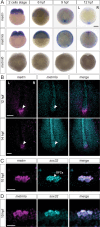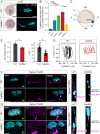Meteorins regulate the formation of the left-right organizer and the establishment of vertebrate body asymmetry
- PMID: 40748055
- PMCID: PMC12316458
- DOI: 10.7554/eLife.105430
Meteorins regulate the formation of the left-right organizer and the establishment of vertebrate body asymmetry
Abstract
While the exterior of vertebrate bodies appears bilaterally symmetrical, internal organ positioning and morphology frequently exhibit left-right (L-R) asymmetries. In several vertebrates, including human, mouse, frog, and zebrafish, left-right symmetry-breaking during embryonic development is initiated by a ciliated organ called the Node or left-right organizer. Within the Node, a leftward flow of extraembryonic fluid named the Nodal flow mediates the asymmetric expressions of Nodal factors. Although downstream Nodal pathway components leading to the establishment of the embryonic left-right axis are well known, less is known about the development and formation of the embryonic Node itself. Here, we reveal a novel role for the Meteorin protein family in the establishment of the left-right axis and in the formation of Kupffer's vesicle, the Node equivalent structure in zebrafish. We show that the genetic inactivation of each or all three members of the zebrafish Meteorin family (metrn, metrn-like a, and metrn-like b) leads to defects in properties of the Kupffer's vesicle, caused by impaired assembly and migration of the Kupffer's vesicle forming dorsal forerunner cells. In addition, we demonstrate that Meteorins genetically interact with integrins ItgαV and Itgβ1b, regulating the dorsal forerunner cell clustering, and that meteorins loss-of-function results in disturbed Nodal factor expression and consequently in randomized or symmetric heart looping and jogging. These results identify a new role for the Meteorin protein family in the left-right asymmetry patterning during embryonic vertebrate development.
Keywords: Meteorin; developmental biology; embryonic development; left-right asymmetry; zebrafish.
© 2025, Eggeler et al.
Conflict of interest statement
FE, JB, LB, KD, TA, SA No competing interests declared, FD is affiliated with ZeClinics SL. The author has no other competing interests to declare, FD Reviewing editor, eLife
Figures













Update of
- doi: 10.1101/2023.11.23.568438
- doi: 10.7554/eLife.105430.1
- doi: 10.7554/eLife.105430.2
Similar articles
-
Klf8 regulates left-right asymmetric patterning through modulation of Kupffer's vesicle morphogenesis and spaw expression.J Biomed Sci. 2017 Jul 17;24(1):45. doi: 10.1186/s12929-017-0351-y. J Biomed Sci. 2017. PMID: 28716076 Free PMC article.
-
Molecular Pathways and Animal Models of Defects in Situs.Adv Exp Med Biol. 2024;1441:719-738. doi: 10.1007/978-3-031-44087-8_43. Adv Exp Med Biol. 2024. PMID: 38884745
-
Establishment of Cardiac Laterality.Adv Exp Med Biol. 2024;1441:167-183. doi: 10.1007/978-3-031-44087-8_9. Adv Exp Med Biol. 2024. PMID: 38884711 Review.
-
Kupffer's vesicle is a ciliated organ of asymmetry in the zebrafish embryo that initiates left-right development of the brain, heart and gut.Development. 2005 Mar;132(6):1247-60. doi: 10.1242/dev.01663. Epub 2005 Feb 16. Development. 2005. PMID: 15716348
-
Mechanisms of left-right symmetry breaking across scales.Curr Opin Cell Biol. 2025 Aug;95:102564. doi: 10.1016/j.ceb.2025.102564. Epub 2025 Jun 21. Curr Opin Cell Biol. 2025. PMID: 40544609 Review.
References
MeSH terms
Substances
Grants and funding
LinkOut - more resources
Full Text Sources

